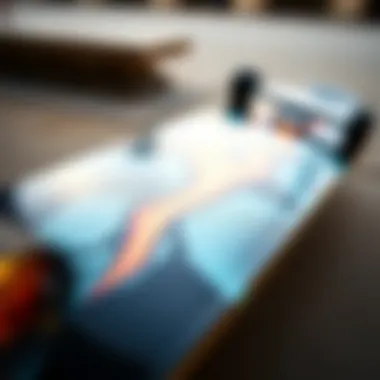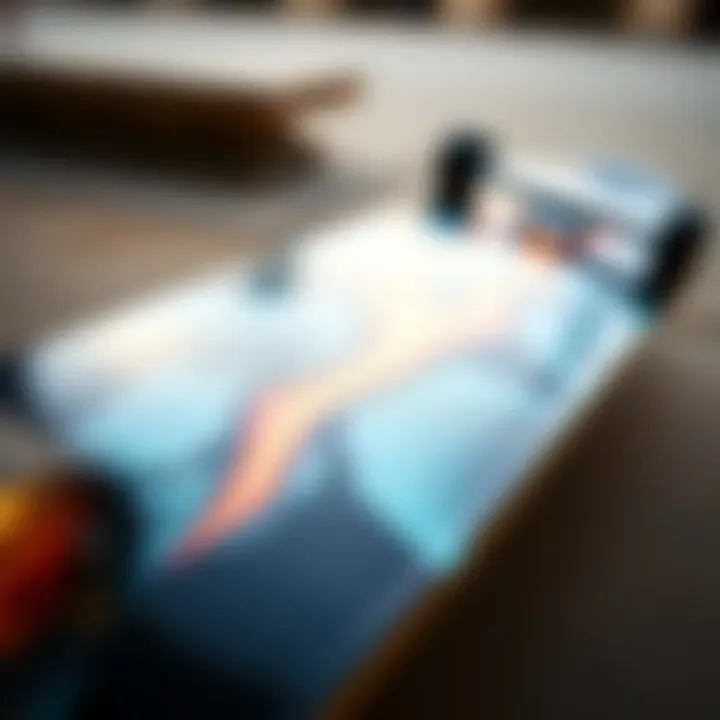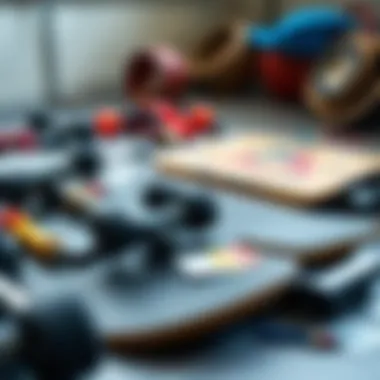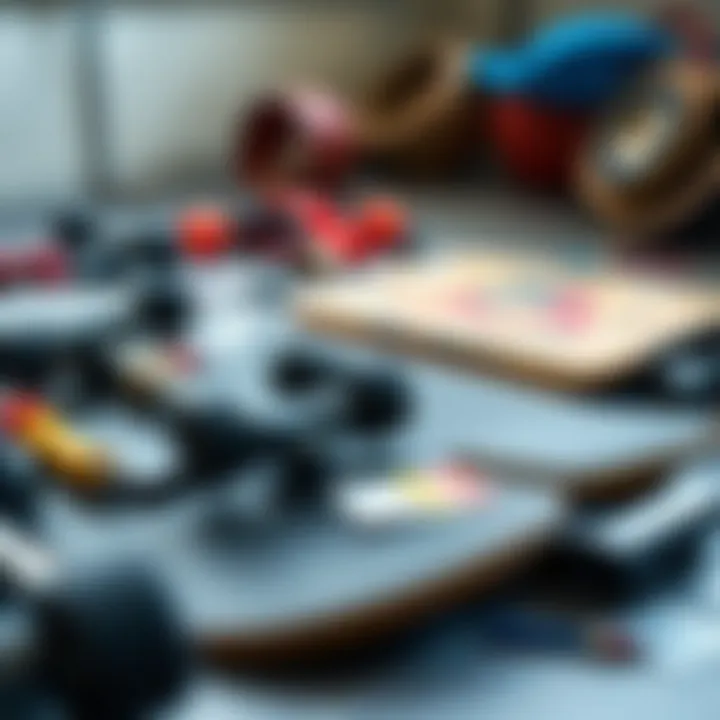Exploring New Skateboard Innovations and Trends


Intro
Skateboarding is no longer just a pastime; it has become an intricate part of youth culture and a global movement. As the wheels have turned, the sport has evolved beyond the flatlands of suburban driveways. The evolution of the skateboard itself, particularly in the past few years, reflects a fascinating intersection of technology, design innovation, and cultural trends. Today’s skateboards are not merely boards with wheels; they represent a canvas for self-expression and a vehicle for community engagement.
This exploration will take you through the latest developments in skateboard design and technology, illuminating what defines the new skateboard. It will also delve into the trends that are shaping the market and how these innovations are impacting not only the riders but the entire skateboarding community. With insights aimed at enthusiasts, hobbyist, and retailers, this article unpacks how skateboarding continues to push boundaries and redefine norms.
Techniques and Tricks
Basic Tricks for Beginners
While some may think skateboarding is all about flair, it’s vital to lay a strong foundation. Newcomers should familiarize themselves with essential tricks that build confidence and skill.
- Ollie: The fundamental trick that allows you to jump and clear obstacles.
- Shuvit: A sideways spin of the board while keeping your feet in place.
- Kickflip: A combination of an Ollie and a flip, this trick tests your timing and coordination.
These tricks not merely enhance balance but also aid in understanding the dynamics of the skateboard. As you learn, always remember to wear protective gear to minimize any injury risk.
Advanced Techniques for Pro Skaters
Once the basics are mastered, pros often push the limits with complex tricks that demand skill and creativity.
- 360 Flip: A combination of a flip and a shuvit. Perfect for those looking to showcase their prowess.
- Heelflip: Similar to the kickflip but initiated with the heel, adding variety to your trick repertoire.
- Noseblunt Slide: This requires sliding the nose of the board along a rail or curb, showcasing board control and finesse.
Incorporating these advanced techniques into your skate routine allows for not only personal growth but also the opportunity to engage with fellow skaters, sharing techniques and tips.
Gear and Equipment
Essential Skateboarding Gear
As much as technique matters, having the right gear can make all the difference. Top equipment ensures safety and enhances performance. Here’s what you shouldn’t skimp on:
- Helmet: A must for protection, especially for novices. Safety first!
- Skateboard: Choose one that suits your style; from street boards to longboards, the options are vast.
- Shoes: Opt for skate shoes that have grip and durability; they are designed to handle the wear and tear of skating.
Latest Trends in Skate Gear
The skateboard industry is not stagnant; it constantly adapts to the preferences and needs of skaters. Increasingly, eco-friendly materials are being utilized. For instance, bamboo skateboards have gained popularity. Additionally, tech innovations like built-in sensors that track performance are emerging in the market, allowing skaters to analyze their tricks and improve.
"Skateboarding gear is evolving; it’s not just about style anymore, but also about safety and sustainability."
By recognizing and embracing these trends, skaters not only contribute to a thriving community but also ensure they remain safe on their rides.
Stay tuned as we continue to explore the multifaceted evolution of skateboards and the role they play in today’s culture. For deeper dives into skateboarding history and techniques, resources like Wikipedia and discussions on Reddit offer rich insights.
Through this narrative, we aim to engage everyone from jersey-wearing beginners to hardcore pros, blending our passion for skating with an awareness of the continuous evolution that it undergoes.
Understanding the Mechanics of a New Skateboard
Skateboarding has morphed into a vibrant cultural touchstone, but at its heart, it’s still about the mechanics. Grasping how a skateboard is built and functions serves as the foundation for enthusiasts. By understanding the essential parts, skaters make informed choices, enhancing their experience, performance, and safety.
Several aspects dictate the ride quality and durability of a skateboard. Different parts, from the deck to wheels, have specific characteristics that contribute to overall performance. With the recent surge of innovation in skateboard design, a conversation about these mechanics is not just relevant; it’s critical.
Defining Key Components
The Deck: Materials and Construction
The deck is the flat board that supports the rider, right? But it’s more than just a platform; it’s a crucial piece of the puzzle. Today’s skateboards often feature materials like maple, bamboo, and high-tech composites. Each has its pros and cons.
For instance, maple wood is tough and resilient, giving great pop, while bamboo offers flexibility and a lightweight feel. But it might not be as enduring as its maple counterpart.
A well-constructed deck allows for better balance and control, vital for tricks and maneuvers. Skaters looking for performance will often choose a material that balances durability with lightweight characteristics. Any skater aiming for high performance should consider what goes into that deck.
Trucks: Functionality and Design
Trucks are the metal part that connects the wheels to the deck. They allow the skateboard to turn and navigate through various terrains. The design of trucks can vary significantly, influencing how agile or stable a skateboard will feel. Most trucks include features like adjustable pivot cups, which make turning smoother, and the width of the truck can affect stability. For instance, wider trucks offer a more stable ride but can be tougher to maneuver, while narrower ones allow for quirky tricks and tight turns. In street skating, this adjustment can make a huge difference.
Understanding how to select the right truck can dramatically impact overall maneuverability. Whether a skater’s style is cruising around town or performing mind-bending tricks, the right choice here is critical.


Wheels and Bearings: Choosing the Right Setup
Wheels and bearings can make or break the skating experience. Wheels vary in size, hardness, and material. Softer wheels provide better grip and a smoother ride over rough surfaces, while harder wheels are generally faster on smooth terrain but can be bumpy.
Bearings, too, play an essential role in the smoothness and speed of a skateboard. ABEC ratings often come into play here; higher ratings suggest better precision and a smoother glide. However, there are plenty of factors at play here, including lubrication and material quality.
Selecting the right wheels and bearings setup is crucial and can greatly enhance performance, depending on the rider’s intent. Serious skaters must think about every detail in this aspect to ensure they get the best ride.
Balancing Durability and Performance
Material Advances and Their Impact
Skateboard materials have come a long way, haven’t they? The emergence of advanced materials like carbon fiber has influenced skateboard design and performance drastically. These innovations lead to lighter, stronger decks, promoting higher skill levels and diverse styles.
Carbon fiber, for instance, is considerably lighter than wood but adds significant rigidity. This balance between durability and weight can be the difference between landing a trick or going home disappointed. As a result, riders are now more equipped to push the boundaries of skateboarding, unfolding new tricks and styles.
Testing for Resilience
Ensuring that a skateboard stands the test of time and trick is paramount. Manufacturers now implement rigorous testing methods to assess how decks hold up under various conditions. This might include stress tests for popping, sliding, and even impacts from jumps.
Skaters have come to appreciate boards that survive after numerous sessions. More so, feedback from the community plays a significant role in how companies evolve their products. This adaptation leads to better designs and superior performance in the long run.
Performance Under Various Conditions
The performance of a skateboard doesn't just rely on how it’s made; environmental conditions have an impact, too. For instance, a wet or rough surface can alter how well a skateboard rides.
Skateboards designed with all-terrain capabilities often include different rubber composites for better grip and flexibility. A design that holds up on a smooth sidewalk may falter over gravel. Pros understand how to communicate their needs to manufacturers—they aren’t just using a board; they’re choosing a tool for success.
By internalizing how these mechanics work, skaters can make educated decisions. Opting for the right components leads to more enjoyable and successful skating experiences, launching each journey into the realm of possibility.
Trends Influencing New Skateboard Designs
The world of skateboarding is always changing, and understanding these trends is essential for anyone involved, whether you're a skateboarder, a manufacturer, or an enthusiast. The trends influencing skateboard designs today echo larger shifts in society, touching on sustainability, technological progression, and cultural dynamics. These elements not only shape what we ride but also how we relate to the act of skating itself.
Sustainability in Skateboard Manufacturing
Eco-Friendly Materials
Eco-friendly materials have become a cornerstone in the conversation about sustainable skateboard production. These materials often include bamboo, recycled plastics, and sustainably sourced wood, each with distinct benefits. Bamboo, for instance, is not just lightweight but incredibly strong, which makes it a suitable alternative to traditional hardwoods. Moreover, its rapid growth and renewability enhance its appeal.
On the other hand, recycled plastics are used to create components that might typically be discarded, offering a second chance to materials that otherwise contribute to landfill waste. Choosing eco-friendly materials isn’t just about being trendy; it symbolizes a deeper commitment to sustainability that resonates with today’s environmentally conscious consumer. The unique feature of these materials is their contribution to reducing the carbon footprint of manufacturing. However, while these materials can sometimes be pricier, their long-term environmental benefits often outweigh the initial investment.
Production Processes Reducing Waste
Production processes have evolved significantly to minimize waste. Manufacturers are adopting methods like CNC cutting that create precision cuts with little leftover material. This not only fosters efficiency but produces boards that fit together better during assembly. Another approach involves the upcycling of scrap materials to create new products, ultimately diverting them from waste streams.
The key characteristic here is the shift toward a circular economy, where waste is minimized, and resources are reused. Producing with this mindset proves beneficial and can enhance a company’s brand image among eco-conscious skateboarders. However, the transition to these processes might require significant upfront investment in new technologies or retraining staff, which can be a hurdle for some manufacturers.
Market Demand for Sustainable Options
Consumer preference is increasingly swayed towards sustainable options. There's a growing awareness among skaters about the environmental impact of their purchases. This shift can be observed through market surveys showing that a significant percentage of buyers are willing to pay a premium for sustainable products. The unique feature of this demand is that it encourages companies to innovate and prioritize sustainability in their business practices.
However, the interest in sustainable skateboards is not without challenges. Companies must balance the costs of sustainable options against consumer price sensitivity. As production scales, manufacturers face the dilemma of maintaining quality while keeping prices competitive. The future seems to suggest that demands for eco-friendly options will only increase as more consumers dedicate themselves to environmentally friendly lifestyles.
Technological Advancements
Smart Skateboards: Features and Functionality
The innovation wave includes smart skateboards, equipped with features that enhance both performance and safety. Elements like GPS tracking, speed monitors, and connection to mobile apps allow riders to better understand their skating habits. The real-time feedback empowers skaters to refine their techniques, making improvement more achievable.
Moreover, these boards often interface with mobile applications that provide data analytics, connecting physical performance with digital insight. However, smart skateboards tend to be heavier and more expensive than traditional boards, which could deter skaters who value simplicity and low costs.
Blockchain for Authenticity and Tracking


Blockchain technology is carving out a niche in the skateboarding industry. By using it, manufacturers can provide transparency around the provenance of materials used in each skateboard. Additionally, it enables buyers to verify the authenticity of their purchases, thwarting counterfeit products. The key characteristic of blockchain is its decentralized nature, which makes the information accessible and tamper-proof. This innovation is particularly valuable in a market with many brands vying for consumers' attention.
Nevertheless, understanding blockchain and integrating it into traditional manufacturing practices can be complex, presenting challenges for companies that are not tech-savvy.
Integration of Augmented Reality
Augmented reality (AR) is another technology slowly making its way into skateboarding. AR can enhance the learning experience by overlaying digital phenomena onto the real world, like showing skaters how to execute specific tricks or providing feedback on their form through tutorials. This interactive experience can keep users engaged, providing immediate visual context when learning new skills.
However, while AR presents incredible learning opportunities, its popularity depends on the widespread availability of compatible devices, which may not be the case for all skaters. Also, there is a question of whether traditional skaters will embrace such high-tech elements, as some prefer a more analog experience.
In summary, the trends influencing new skateboard designs highlight the intersection of culture, environment, and innovation. Whether through material choices or technological advancements, these developments show a conscious effort to meld the essence of skateboarding with the needs and values of modern society.
Cultural Impact of the New Skateboard
The cultural significance of the new skateboard transcends mere transportation; it embodies a lifestyle and represents the aspirations of a generation. As skateboarding evolves, so too does its influence on art, fashion, and community dynamics. This evolution shines a light on how the skateboard isn't just a tool for tricks, but a canvas for personal expression and communal identity in the contemporary world.
Skateboarding as a Lifestyle
Brand Collaborations with Artists and Influencers
The intersection of skateboarding and art has been a rich vein for brands looking to resonate with both seasoned athletes and newcomers alike. Collaborating with artists and influencers breathes life into boards, making them appeal to diverse audiences. Artists like Shepard Fairey have become synonymous with skate culture, bringing unique designs that are not only visually stunning but also resonate on social issues that skateboarders often confront.
The key aspect of these collaborations is about authenticity. When a brand partners with an artist who embodies the ethos of skateboarding, the result can be a product that tells a story and matches the aesthetic of its audience. This combination can transform skateboards into items that are as much about art as they are about function, appealing to collectors and casual riders alike.
However, the downside is the potential for commercialization. Skaters might feel that their culture is diluted when brands overly pursue profit through such collaborations without a genuine understanding of the community.
Fashion Trends Associated with Skate Culture
Fashion trends in skate culture are evolving alongside skateboards themselves. The oversized tees, baggy pants, and chunky sneakers have made their way from ramps and streets to high-end runways. Brands like Vans and Supreme have tapped into this blend of function and fashion, creating gear that feels just as at home in a skatepark as it does in a city café.
A pivotal feature here is how these fashion statements often carry a message of independence and rebellion. Many skaters embrace clothing that reflects their individuality over trends dictated by mainstream culture. However, as skate fashion gains traction in mainstream fashion, purists can sometimes perceive this as a dilution of the scene’s authenticity, bringing both acceptance and criticism into the mix.
The Shift in Public Perception
Public perception of skateboarding has undergone a remarkable transformation in recent years. Once viewed as a rebellious pastime associated with delinquency, skateboarding is now celebrated for its athleticism and creativity. The inclusion of skateboarding in the Olympics has certainly played a role in shifting this narrative, legitimizing the sport in the eyes of mainstream society.
The prominent characteristic of this shift is the growing recognition of skateboarding as a legitimate form of art and sport. Media coverage and documentaries highlight the skill and discipline required, showcasing riders who might have once been dismissed as mere troublemakers. This advancement in public sentiment highlights the wide-ranging appeal of skateboarding across ages and demographics.
Yet, with this newfound status, there are concerns about the commercial pressures that come along with it. As skateboarding becomes more mainstream, there is a risk of losing the raw, grassroots nature that originally defined the culture. Balancing authenticity with wider acceptance remains a challenge for skaters entrenched in their passionate culture.
Community Engagement and Events
Competitions and Festivals: Highlights
Skate competitions and festivals form the backbone of community engagement in skate culture. Events like the X Games and Street League Skateboarding gather skaters from around the world, providing not just a platform for competition but also a celebration of the culture itself. These events bring together diverse groups, uniting skaters of various backgrounds and styles.
The essence of these gatherings is about more than just the tricks and scores; they create memories, friendships, and learning opportunities. The vibrant atmosphere fosters a sense of belonging that is essential to the skate community. Unfortunately, the commercial aspect of sponsorship can sometimes overshadow these grassroots events, prioritizing profit over the spirit of skateboarding.
Local Skate Parks and Their Role
Local skate parks serve as the epicenter of most communities, providing a safe space for skaters to hone their skills and build friendships. These parks often become essential in nurturing young talent and fostering inclusivity. Many local parks host workshops and clinics that make skateboarding accessible to beginners, particularly children and youth.
A key characteristic of skate parks is their role in bridging gaps within the community. They invite people from various socio-economic backgrounds to come together in a shared passion. However, not all communities have access to a well-designed park, which can exclude potential skaters and hinder community development.
The Importance of Inclusivity in Skate Culture
Inclusivity in skate culture has become a prevailing theme, emphasizing that skateboarding should be accessible to everyone, regardless of their background, gender, or skill level. Many movements within the skateboarding community advocate for the representation of minorities and underrepresented groups, promoting a culture where everyone has a place to thrive.
An important aspect of inclusivity is its power to break down barriers. Skate events increasingly showcase diverse skaters, creating role models for young riders who might see themselves represented for the first time. On the flip side, there may be resistance from certain segments of the traditional skate community who fear that inclusivity efforts might weaken their established culture.
In essence, the cultural impact of the new skateboard encompasses far more than physical tricks and styles; it weaves together a rich tapestry of community, art, and individuality that continues to evolve. As the skateboard grows in influence, so does its potential to inspire and unite, shaping new narratives for generations to come.
The Role of Innovation in Skill Development


Innovation plays a critical role in shaping how skaters develop their skills and push the limits of what is possible on a skateboard. As design and technology advance, the learning curve for new and experienced skaters can be both accelerated and enhanced. New gear amplifies the ability to learn, practice, and master various techniques. This not only benefits individual riders but also contributes to the culture and community surrounding skateboarding.
Advancements in skateboard technology don't just cater to professional skaters; hobbyists and beginners equally gain from improved gear, making the sport more accessible and inviting to a wider audience. The incorporation of innovative features encourages exploration and experimentation, allowing skaters to tackle more complex maneuvers with confidence.
How New Gear Influences Techniques
Adapting to New Board Features
When skateboard manufacturers incorporate modern features into their boards—such as concave shapes, enhanced grip, or lighter materials—skaters must adapt their techniques accordingly. New board features can significantly change the way tricks are executed. The introduction of flex technology, for instance, alters how a skater approaches jumps or landings. A deck with improved pop allows for higher ollies and flips, making it a popular choice among skaters aiming for progression. However, the downside can be an initial adjustment period where skaters may struggle to adapt to the new waves of dynamics that these boards bring.
Training Regimens for Advanced Moves
Training regimens have also evolved alongside the advancements in board technology. With specialized training now available, skaters can customize their practice sessions to focus on specific skills or tricks. This structured approach is beneficial, especially for those looking to refine their capabilities. For example, skaters can now design routines that center around mastering intricate flips or grinds while utilizing boards that specifically cater to those tricks. While this tailored training can yield impressive results, it can also foster a sense of competition that may overshadow the enjoyment aspect of skateboarding for some individuals.
Community Learning and Sharing Techniques
One of the standout characteristics of skateboarding culture is the community aspect, particularly how skaters learn from one another. Innovations have bolstered these communal efforts. Skate parks often serve as hubs for skill-sharing, where skateboarders come together to teach and learn new tricks. Online forums and social media platforms have also widened this circle, allowing for knowledge exchange beyond geographical confines. This communal learning approach fosters a supportive environment but can occasionally lead to pressure as skaters feel compelled to keep up with their peers, potentially stunting personal growth.
Accessibility of Skateboarding Resources
Online Platforms for Learning Skills
The rise of online platforms dedicated to skateboarding education has democratized access to skill development resources. Websites like YouTube offer an abundance of tutorials and trick tips that can be accessed from anywhere, making learning much more convenient. As a result, skaters can enter the sport armed with knowledge and insights gained from experienced riders, helping to bridge knowledge gaps that once existed. However, with so many options available, skaters might find it overwhelming to discern which resources are truly useful.
Tutorials and Workshops: Bridging Knowledge Gaps
In-person tutorials and workshops have also gained traction, often organized by local skate shops or sponsored events. These sessions provide invaluable hands-on experience and direct feedback from seasoned professionals. Attending workshops not only improves skating skills but also creates a sense of belonging within the skate culture. Nonetheless, logistical challenges such as location and costs can be barriers for some aspiring skaters.
Parental Guidance: Supporting Young Skaters
For younger skaters, parental involvement plays a pivotal role in skill development. Parents who take an interest in their child’s passion can significantly influence their trajectory in skateboarding. Whether it’s coordinating trips to the skate park or investing in quality gear, the support from parents often empowers young skaters to push their limits. On the flip side, over-involvement can lead to pressures that detract from the fun aspect, turning skateboarding into a chore rather than an enjoyable pastime.
Innovation in skateboarding is not solely about what’s under the feet of skaters but extends to the community, culture, and resources that support their journey.
In summary, whether it's through the gear they ride or the environments they learn in, innovation plays a crucial role in enhancing skills among skateboarders—creating pathways to mastery that were not readily available before.
The Future of Skateboarding: A Look Ahead
The future holds a treasure trove of potential for skateboarding, reflecting not just a sport but a dynamic culture. As skateboarding continues to evolve, understanding the trajectory of its market and cultural relevance becomes paramount. This section explores various elements shaping the future of skateboarding, with an eye toward innovations and shifts that promise to redefine the experience.
Predicting Market Trends
Emerging Brands to Watch
New brands like Jart Skateboards and Darkstar are carving out niches in the marketplace, noticeable for their innovative designs and sustainable materials. Their fresh takes not only cater to preferences for durability but also embrace eco-conscious consumers by sourcing recycled materials. These brands frequently use lightweight composites that enhance agility, making them appealing to both beginners and seasoned pros. However, the challenge lies in establishing brand loyalty against longtime giants like Element or Baker, which might have more entrenched consumer bases.
Consumer Preferences Shaping the Market
Consumer preferences dramatically shape the products available. Today’s skaters are increasingly drawn to personalized gear that reflects their identity and values. Among the various options, custom graphic decks have surged in popularity. This shift indicates a desire for self-expression, making customization a key factor for brands looking to stay relevant. The challenge here is balancing quality and personalization, as consumers often wary of sacrificing performance for unique aesthetics.
Projected Technological Advancements
The anticipated advancements in technology are a driving force for what’s ahead. Innovations like smart skateboards integrated with sensors can provide real-time feedback on performance metrics, offering a distinct advantage for serious athletes. These boards can analyze tricks and skills, which fosters improved techniques and helps adjust training regimens. However, the reliance on tech can also alienate purists who appreciate the raw nature of traditional skateboarding.
Long-Term Cultural Shifts
Globalization of Skate Culture
The globalization of skate culture represents an essential aspect of its evolution. With the rise of social media platforms like Instagram, the boundaries of local skate scenes have blurred, giving rise to a shared global narrative. Skaters from different corners of the world can connect and collaborate, sending creative ideas across borders. However, this interconnectedness raises questions about cultural appropriation versus appreciation, challenging enthusiasts to navigate complex dynamics of authenticity in their skate communities.
Impact of Urban Development on Skate Spaces
Urban development can either breathe new life or stifle skate culture, depending on how cities adapt their infrastructures. Many local governments are beginning to recognize the positive impact skateparks have on communities, which promotes healthy lifestyles among youth. These skate spaces also foster inclusion, allowing skaters from diverse backgrounds to unite. On the flipside, gentrification often leads to the displacement of skate parks, which can create friction between residents and developers.
The Future Role of Skateboarding in Youth Culture
As society evolves, so does the role of skateboarding in youth culture. With its roots deeply entwined in freedom and rebellion, skateboarding has the potential to influence perceptions around self-identity and community engagement. It’s projected that skateboarding will continue to facilitate social change, serving as a platform for youth activism and expression. However, with its mainstream acceptance, skateboarders may struggle to maintain the authenticity that gave rise to their culture in the first place.
The evolving landscape of skateboarding is more than just trends; it encapsulates a living culture that continues to adapt while standing on the shoulders of its vibrant history.
In summary, by assessing market trends, technological advancements, and cultural shifts, one can glean insights into the future of skateboarding. As the landscape continues to change, keeping an eye on these evolving aspects helps forecast potential trajectories that embrace both tradition and innovation while nurturing the spirit of skateboarding.

